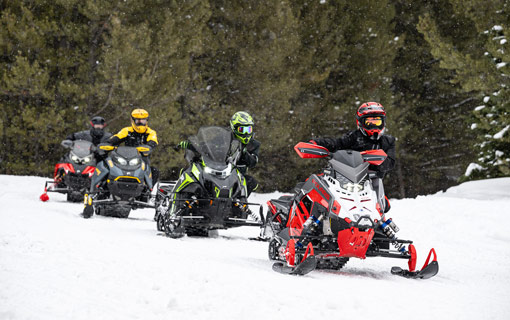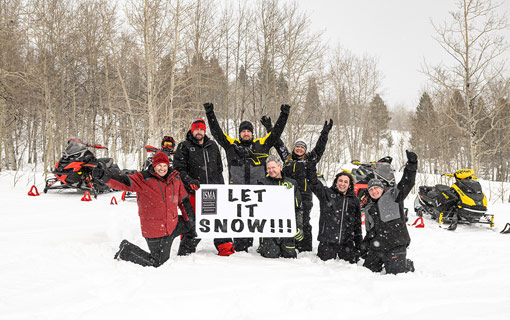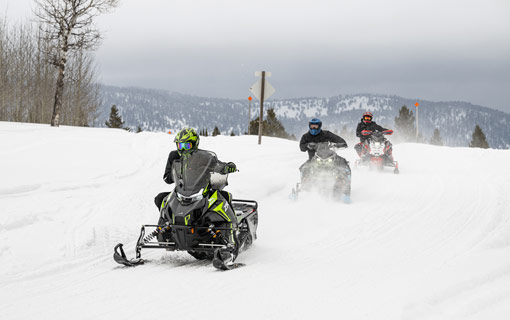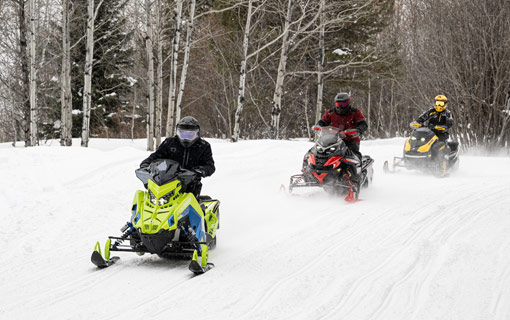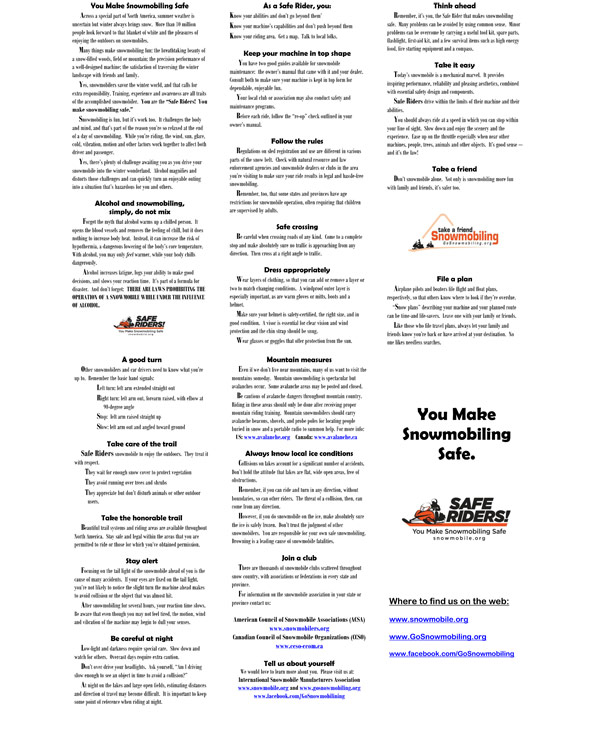Snowmobiling Safety
The Safe Riders! Safety Awareness Program
As part of our campaign to promote snowmobiling safety, we offer our Safe Riders! brochure and materials order form. To order this information package, please visit our Safe Riders! page.
Are you a Safe Rider?
Across a special part of North America, summer weather is uncertain but winter always brings snow. More than 10 million people look forward to that blanket of white and the pleasures of enjoying the outdoors on snowmobiles.
Yes, snowmobilers savor the winter world, and that calls for extra responsibility. Training, experience and awareness are all traits of the accomplished snowmobiler.
Snowmobiling is fun, but it's work, too. It challenges the body and mind, and that's part of the reason you're so relaxed at the end of a day of snowmobiling. While you are riding, the wind, sun, glare, cold, vibration, motion and other factors work together to affect both driver and passenger.
Yes, there's plenty of challenge awaiting you as you drive your snowmobile into the winter wonderland. Alcohol magnifies and distorts those challenges and can quickly turn an enjoyable outing into a situation that's hazardous for you and others.
Alcohol and snowmobiling, simply, do not mix.
Forget that myth that alcohol warms up a chilled person. It opens the blood vessels and removes the feeling of chill, but it does nothing to increase body heat. Instead, it can increase the risk of hypothermia, a dangerous lowering of the body's core temperature. With alcohol, you may only feel warmer, while your body chills dangerously.
Alcohol increases fatigue, fogs your ability to make good decisions, and slows your reaction time. It's part of a formula for disaster. And don't forget—MOST STATES AND PROVINCES HAVE LAWS PROHIBITING THE OPERATION OF A SNOWMOBILE WHILE UNDER THE INFLUENCE OF ALCOHOL.
As a Safe Rider, you:
- Know your abilities and don't go beyond them.
- Know your machine's capabilities and don't push beyond them.
- Know your riding area. Get a map. Talk to the locals.
- Learn more—reading manuals and other materials from manufacturers, administrators and snowmobile associations, or watch videos. Snowmobile clubs, state and provincial associations offer courses, information and activities. Many members are certified driving and/or safety instructors.
Keep your machine in top shape
- You have two good guides available for snowmobile maintenance: the owner's manual that came with the machine and a dealer. Consult both to make sure your machine is kept in top form for dependable, enjoyable fun.
- Your local club or association may also conduct safety and maintenance programs.
- Before each ride, follow the "pre-op" check outlined in your owner's manual.
Follow the rules
Regulations on sled registration and use are different in various parts of the snow-belt. Check with natural resource and law enforcement agencies and snowmobile dealers or clubs in the area you are visiting to make sure your ride results in legal and hassle-free snowmobiling.Remember, too, that some states and provinces have age restrictions for snowmobile operation, often requiring that children are supervised by adults.
Safe crossing
Be careful when crossing roads of any kind. Come to a complete stop and make absolutely sure no traffic is approaching from any direction. Then cross at a right angle to traffic.Dress appropriately
- Wear layers of clothing, so that you can add or remove a layer or two to match changing conditions. A windproof outer layer is especially important, as are warm gloves or mitts, boots and a helmet.
- Make sure your helmet is safety-certified, the right size and in good condition. A visor is essential for clear vision and wind protection and the chin strap should be snug.
- Wear glasses or goggles that offer protection from the sun.
Take a friend
Don't snowmobile alone. Not only is snowmobiling more fun with family and friends, it's safer too!File A plan
Airplane pilots and boaters file flight and float plans, respectively, so that others know where to look if they're overdue."Snow plans" describing your machine and your planned route can be time- and life-savers. Leave only with your family or friends.
Like those who file travel plans, always let your family and friends know you're back or have arrived at your destination. No one likes needless searches.
A good turn
Other snowmobilers and car drivers need to know what you're up to. Remember the basic hand signals:Stop

Left turn

Right turn

Oncoming sleds

Slowing

Sleds following
Last sled in line

Take care of the trail
SAFE RIDERS snowmobile to enjoy the outdoors. They treat it with respect- They wait for enough snow cover to protect vegetation.
- They avoid running over trees and shrubs.
- They appreciate, but don't disturb animals or other outdoor users.
Take the honorable trail
Beautiful trail systems and riding areas are available throughout North America. Stay safe and legal within the areas that you are permitted to ride or those for which you've obtained permission.Stay alert
Focusing on the tail light of the snowmobile ahead of you is the cause of many accidents. If your eyes are fixed on the tail light, you are not likely to notice the slight turn the machine ahead makes to avoid collision or the object that was almost hit.After snowmobiling for several hours, your reaction time slows. Be aware that even though you may not feel tired, the motion, wind and vibration of the machine may begin to dull your senses.
Beware of darkness
Low-light and darkness require special care. Slow down and watch for others. Overcast days require extra caution.Don't over drive your headlights. Ask yourself, "Am I driving slow enough to see an object in time to avoid a collision?"
At night on lakes and large open fields, estimating distances and direction of travel may become difficult. It is important to keep some point of reference when riding at night.
Beware of water
The safest snowmobiling rule is never to cross lakes or rivers. Besides the danger of plunging through the ice, you have far less traction for starting, turning and stopping on ice than on snow.Collisions on lakes account for a significant number of accidents. Don't hold the attitude that lakes are flat, wide open areas, free of obstructions.
Remember, if you can ride and turn in any direction, without boundaries, so can other riders. The threat of a collision, then, can come from any direction.
However, if you do snowmobile on the ice, make absolutely sure the ice is safely frozen. Don't trust the judgement of other snowmobilers. You are responsible for your own safe snowmobiling. Drowning is a leading cause of snowmobile fatalities. Consider buying a buoyant snowmobile suit.
If you go through the ice, remember that your snowmobile suit (even a non-buoyant one) and helmet may keep you afloat for several minutes. Slide back onto the ice, using anything sharp to dig in for better pull. Kick your feet to propel you onto the ice, like a seal.
If the ice keeps breaking, continue moving toward shore or the direction from which you came. Don't remove your gloves or mitts.
Once on the ice, roll away from the hole. Don't stand until well away from the hole.
Mountain measures
Even if we don't live near mountains, many of us want to visit the Cascades, Adirondacks, Rockies or other mountains someday. Mountain snowmobiling is spectacular but can pose extra dangers, such as avalanches. Some avalanche areas may be posted and closed.Be cautious of avalanche dangers throughout mountain country. Riding in these areas should only be done after receiving proper mountain riding training. Mountain snowmobilers should carry avalanche beacons, shovels, probe poles for locating people buried in snow and a portable radio to summon help.
Safe Riders! pledge
- I will never drink and ride a snowmobile.
- I will drive within the limits of my machine and my own abilities.
- I will obey the rules and laws of the state or province I am visiting.
- I will be careful when crossing roads, and always cross at a right angle to traffic.
- I will keep my machine in top shape and follow a pre-op check before each ride.
- I will wear appropriate clothing, including gloves, boots and a helmet with a visor.
- I will let family or friends know my planned route, my destination and my expected arrival time.
- I will treat the outdoors with respect. I will not litter or damage trees or other vegetation.
- I will respect other peoples’ property and rights, and lend a hand when I see someone in need.
- I will not snowmobile where prohibited.
Test your snowmobiling skills
The Safe Riders! Snowmobile Safety Awareness Program provides basic essentials about snowmobile safety and includes short quizzes to help test your knowledge about safe snowmobiling practices. It is meant to supplement information provided by the state or province in which you register or ride your snowmobile, so be sure to check local rules and requirements before venturing out on the snow.
This Program has been produced through a partnership between the American Council of Snowmobile Associations (ACSA), the International Association of Snowmobile Administrators (IASA), and the International Snowmobile Manufacturers Association (ISMA) with financial assistance from the Recreational Trails Program administered by the U.S. Department of Transportation—Federal Highway Administration (FHWA).
For The Love of Snowmobiling!
Photos & videos
Browse our collection of snowmobile safety videos, public service announcements and snowmobile photos.
Snowmobile safety
These safety resources will ensure your next ride will be a safe and fun one for all!
Posters & projects
Download exclusive snowmobiling posters and our fun kid activities!
News & events
Stay informed about the latest news about our favorite recreation and find a snowmobiling event in your state.

